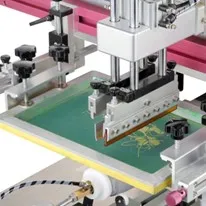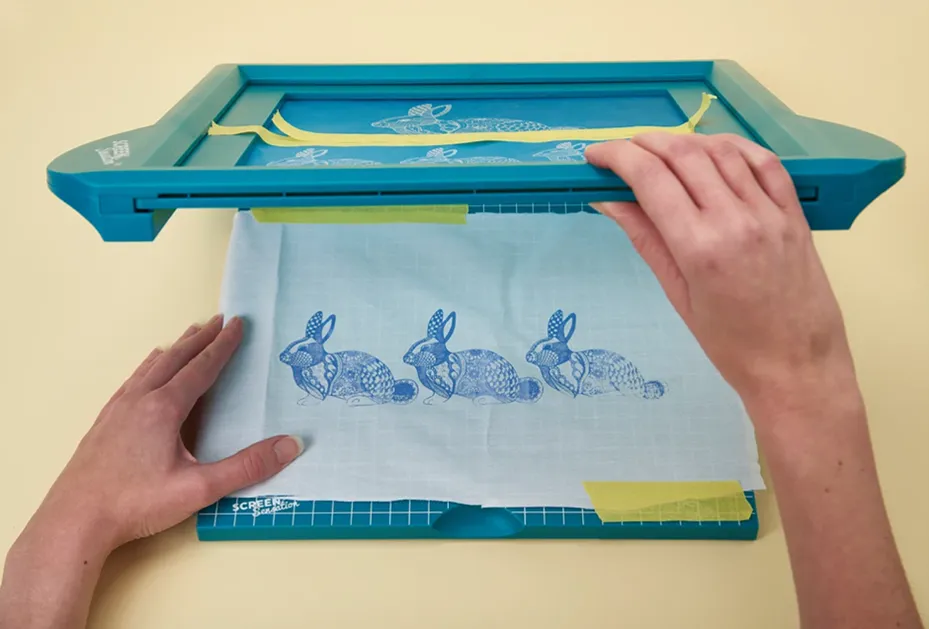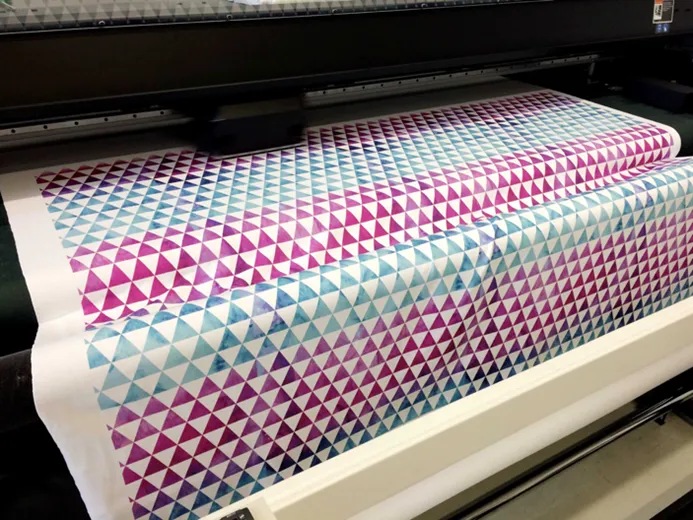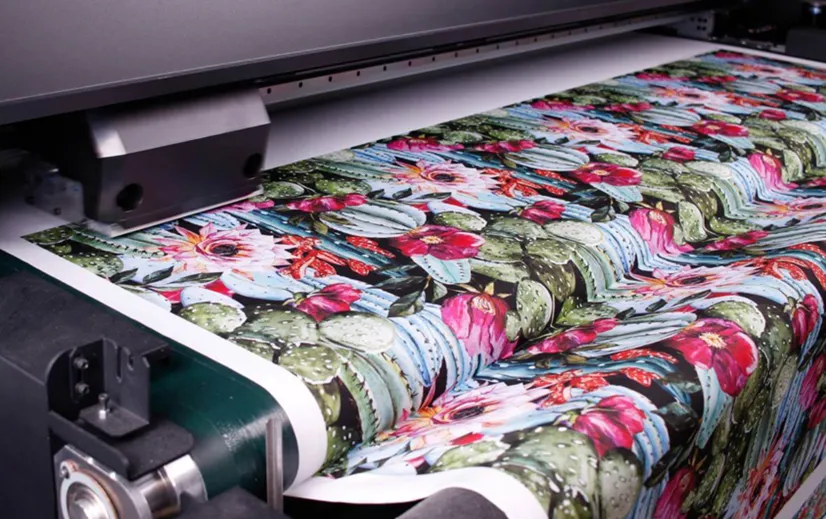Are you looking to choose between screen printing and digital printing? We will look into the basics of both processes and their key differences.
The most fundamental difference between screen printing and digital printing is that screen printing is one of the oldest processes. Screen printing is done with only one color at a time. The digital printing process is much newer and it uses a specialized inkjet printer. So it can produce a full 4-color print in one pass. We will look into it in more detail in this article.
Screen Printing Basics
Screen printing is also called silk-screen printing, Serigraphy, and Serigraph printing. It is one of the oldest methods of printing and has been around since as early as 500 AD and originated in Asia. A fine mesh screen that is made of a tight and thin layer of polyester or silk is used as a stencil. The mesh screen is pre-treated in such a way that it allows the paint to pass only through the desired areas. The printing process is as follows:
- The substrate is held tightly on the machine platform.
- The screen is placed firmly on the substrate.
- The paint is poured on the screen.
- A squeegee or a blade(with a rubber tip) sweeps the paint across the screen, pushing the paint through the permeable holes.
- The screen is removed.
- The paint is cured using a hot-air gun or UV light depending on the type of paint.
The process is usually carried out using more than one screen (stencils) one after the other. Each color in the final design will need a different screen.
Types of Inks That Can Be Used in Screen Printing
There are multiple options with the type of ink that can be used in screen printing. The most commonly used ones are water-based inks and plastisol-based inks.
Water-based inks are eco-friendly options. But they usually produce a dull finish with low accuracy and thin layer deposition. Water-based ink often requires heat to dry.
The plastisol ink on the other hand comes in a lot of different formulations. It usually provides a vibrant finish and a thicker print layer. It can be cured in presence of heat or UV rays depending on the ink formulation.


Digital Printing Basics
Digital printing is relatively a newer and more sophisticated process. It requires a digital file of the print and a specialized printer that comes in many types. The digital printing process can be used when there are too many details in the final design. The colors used in the inks are usually CMYK (Cyan, Magenta, Yellow, and Key). But the combination of these can generate more than 16 million colors and shades.
- Inkjet Printing
It is one of the most commonly used forms of digital printing. The printer copies image from the digital file. The printer uses digital files to map and place minute droplets of ink on the surface to create the desired image.
- Laser Printing
These printers use laser technology to alter the charges of a positively charged drum. The now-negatively charged areas of the drum represent the image that is to be printed. This negatively charged area attracts the toner particles through which the positively charged substrate is passed. The ink gets transferred to the substrate and then it is fused with the substrate in the further steps.
- Solid Ink
The ink in this process is solid at room temperature but the ink is melted by the printer and then it can be handled like any other liquid ink. It solidifies as soon as it cools down on the substrate. It also offers the advantage of not drying out in the nozzles of the printer and also it does not wick into the substrate like liquid inks. It provides a precise, bright, and vivid finish.
- Dye Sublimation
A dye-sublimation printer works by heating ink and then depositing it onto a transfer paper. This transfer paper is then placed against the substrate and intense heat is applied. The substrate can be anything from fabric to hard substrates like a ceramic mug or bottle.
- Flatbed Printing
This printing process uses an inkjet printer to print on a variety of substrates of different sizes and materials. The main difference lies in the type of ink, its curing process, and the substrate size flexibility that it offers. It uses ink made of acrylic monomers which cure upon exposure to UV light. The bed is adjustable so it can accommodate substrates of various thicknesses.
- Roller Printing
Roller printing is also called intaglio or machine printing. It is one of the oldest mechanized methods of the continuous printing process. It is more relevant when the printing needs to be done in very large batches. The design is engraved on copper rollers and each color in the final design will require a different set of rollers. The printing paste is transferred through a transfer roller to the engraved rollers. The pressure of the engraved rollers against the substrate transfers the design to the substrate.


Key Differences Between Screen Printing and Digital Printing
Cost of Project
When considering setting up a unit for your project. The setup cost for screen printing will require a bigger initial investment as compared to digital printing. Investing in screen printing will be a sensible choice when the same simple design needs to be created on a large number of pieces. It will require investing in different screens for different design patterns. Digital printing, on the other hand, does not require any investment in tools or stencils for different designs. But it is a relatively slow process. So the cost of inkjet printing will make sense when the quantity is not much and the design printed keeps changing.
Print Quality
Screen printing uses spot colours for printing which makes it a better option to achieve vibrant colours like red, oranges, green and grey. The deposition of colour in screen printing is continuous and usually thicker. So the visibility of the design pattern is quite good. The paint often looks slightly raised from the substrate surface and it also alters the softness of the fabric in the painted area.
The inkjet digital printing works on the CMYK colour model. This is a subtractive model and hence the brighter colours are difficult to achieve. The print layer is very thin and does not form a continuous layer hence it does not offer design visibility like that of a screen print. However, because of the lower paint layer thickness, the print looks flush with the surface. And so it provides a feeling that it is a part of the substrate. The fabric’s softness remains consistent in the digital printing process.
Print Complexity
The screen printing process can only print one colour at a time. So the complexity of the design significantly affects the price and feasibility of screen printing. The complicated colour pattern designs cannot be realistically done with screen printing. However, digital printing allows complicated images with many details and colour gradients.
Print Life (Adhesion and durability)
Adhesion is driven by the chemistry of how the ink works. So a lot of different types of ink are available for both screen printing and digital printing processes. Screen printing builds a thicker layer of paint and hence it is generally more durable and weather-resistant. A clear coat can also be done as the last layer in screen printing which further enhances the life and visibility of the print. To ensure similar adhesion of the paint on the substrate, the digital printing inks are generally costlier than the screen printing inks.
Effect on Environment
In the screen printing process, the screens must go through a cleaning process using fresh water and chemicals. This hazardous wastewater either needs to be treated or will be directly disposed of on the ground. All of them will negatively impact the environment. Digital printing on the other hand is a relatively cleaner process. It does not require frequent cleaning. And hence it does not create significant waste in form of residual ink paste or contaminated water.
Final Word
Overall, you will need to detail the following things while choosing between screen printing and digital printing:
- The complexity of print – for complicated prints, go for digital printing
- The scale of a project – Larger quantities of the same design will be cost-effective with screen printing. And smaller quantities will be cost-effective with digital printing.
- Print quality and finish – There are trade-offs. The visibility is better with screen printing but the details are better with digital printing. We recommend you evaluate the preference of your end user
- Environmental Effect – We strongly recommend handling the wastewater properly. Please check your local legal restrictions before deciding to go ahead with the screen printing. If you don’t want to get into any of this, digital printing is the option for you.
